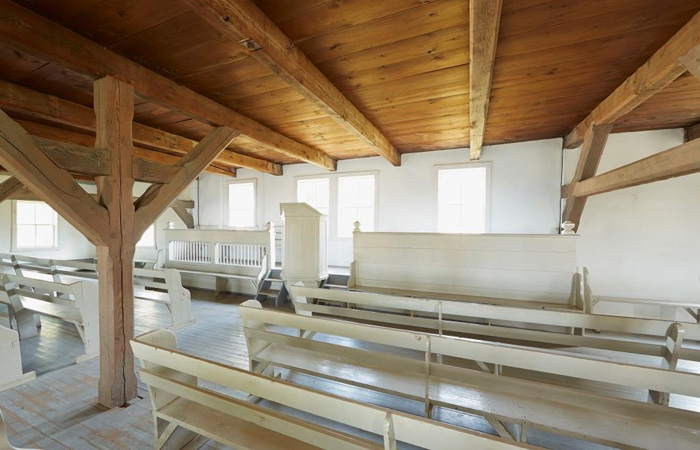Village News
What the Old Colony Worship House Offers Us Today

I walked through the village on a bright and sunny morning on Monday. The birds were chirping, the sun was warm, the air was crisp, and the village was quiet. Outside of our main tourist season, the village is typically pretty empty, but the emptiness struck me that day because it mirrored the quiet I’d experienced on the way to work in a way that is pretty unusual for a Monday morning. These days the traffic is lighter than usual, the crowds are dispersed, and the world is all around a much quieter place while everyone hunkers down to do their part to flatten the curve of COVID-19.
To do its part, MHV is currently closed to the public until April 30. Even so, as I think about what our quiet village has to offer in these uncertain times and even while we’re closed, I think about the Old Colony Worship House. It was built in 1881 in the village of Chortitz, near Winkler, on the former Mennonite West Reserve. In its very architecture, it speaks to the need to care for each other and demonstrates one of the ways community needs were met in a practical way in the past.
At first sight, the heavy, load-bearing columns and beams in the Old Colony Worship House are curious. What are they doing there and why such a heavy supporting framework to bear the weight of an attic in a building used for worship? When I ask them to guess the purpose behind the supporting structure, museum visitors often surmise that perhaps there was a library in the attic and the beams are there to bear the weight of all those books. It’s an interesting guess, but it’s incorrect.
The attic of the Old Colony Worship house did have a lot of weight it in, but it was the weight of grain that caused the need for such structure to support the attic. The grain was donated by community members, collected and stored in the worship house’s attic, and then doled out by the church’s deacons to meet the practical needs of the Gemeinde, or community. In a rural, agricultural setting, giving grain in times of need didn’t just help to feed a family, but it also could provide the means to start a new crop the next year, if a family had lost its own stores of seed grain through, for example, a fire in their housebarn. Eventually the practice of community members contributing grain to the deacon’s “fund” was replaced by donating money, making the support structure inside the Old Colony Worship House unnecessary. At that time, the beams were removed from the meetinghouse. However, when the building was moved to Mennonite Heritage Village (MHV) in 1967, the building was restored to its appearance around the time it was built and replica support beams were installed to mirror the type of support structure the interior would have had.
During this time, I invite you to reflect on how you can support the practical needs of your community. In part, that means most of us will be staying home as much as possible over the next while, but there are other needs that we can meet even while practicing responsible social distancing. Pick up the phone and call your neighbour, offer to do some grocery shopping for those who are unable to go out. Even today, the architecture of the Old Colony Worship House, built nearly 140 years ago, tells us that we all bear responsibility for the needs of the community and we can all play a part in meeting those needs and taking care of one another.




